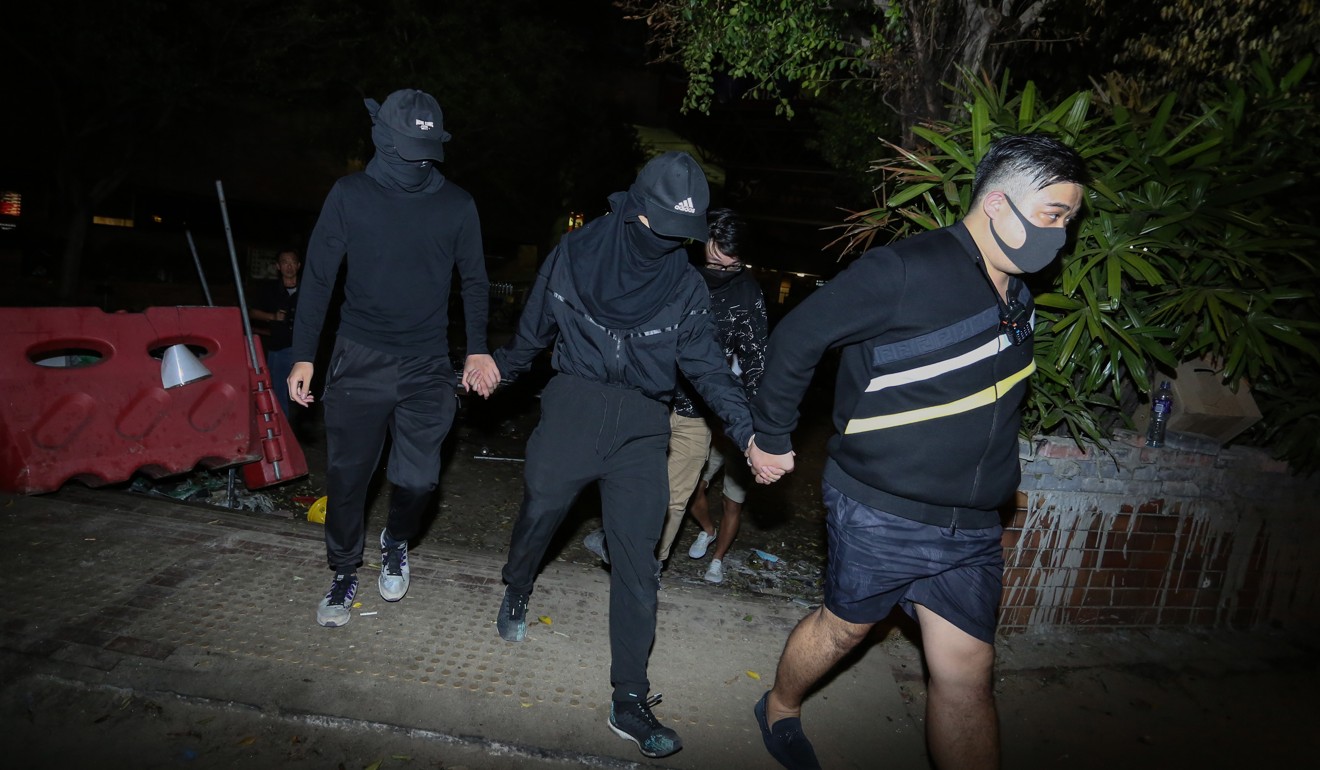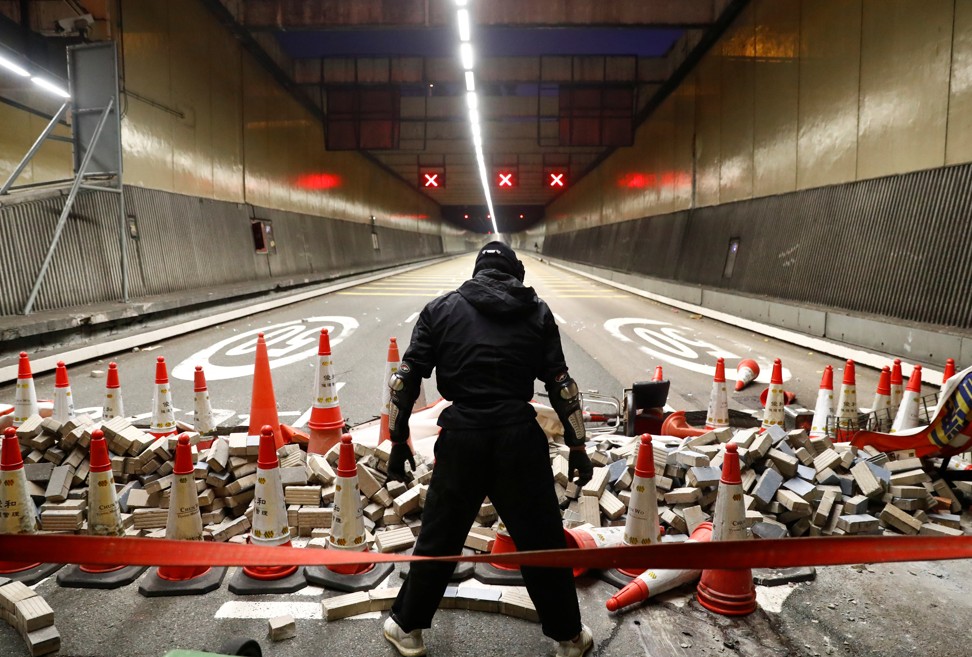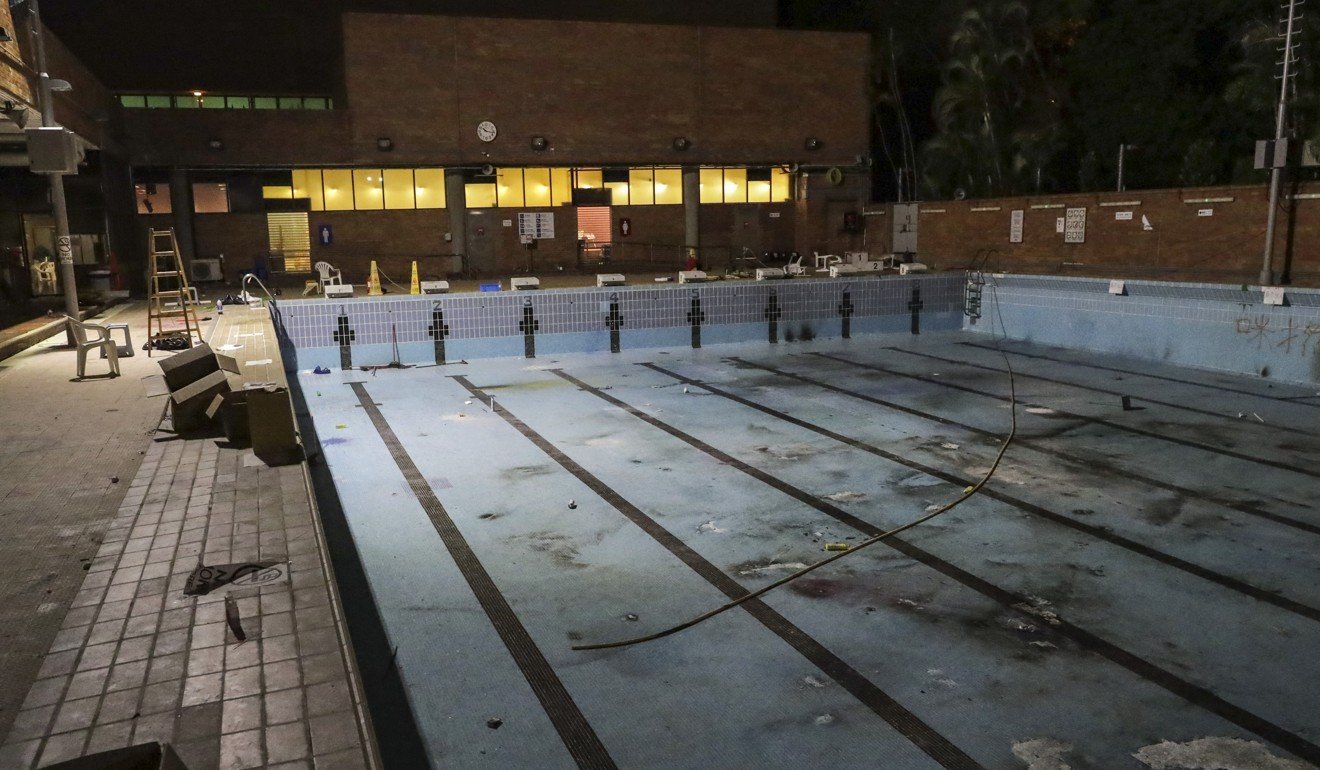
From war zone to ‘prison’: voices from Polytechnic University siege, site of some of the worst violence amid Hong Kong’s protest crisis
- Radicals and volunteers give their account of being part of the fierce clashes with police
- Wrecked campus turned into a wasteland as stand-off dragged on for more than a week
On Thursday morning last week, James (not his real name) made his dash for freedom from the wreckage and rotting filth of the Hong Kong Polytechnic University in Hung Hom.
He had tried once before to escape, by jumping into a manhole and crawling through the narrow sewers, but gave up when it became too unbearable.
“I was down there for about 13 minutes and only managed to go for 100 metres. I had to almost kneel down and walk like a frog,” he said. “It was so smelly and dirty, beyond what you can ever imagine.”
Then, early on Thursday morning, he noticed there were no police officers guarding the roads near one of the campus buildings.
The 22-year-old, who studies at a PolyU community college, took off.
“I ran across two highways and through some bushes. I just kept sprinting. I just wanted to get home, have a bath, lie on my bed and put an end to this,” he said after he escaped.
There has been no sign of any protesters still holed up inside, though some could still be hiding in classrooms. A message scrawled across the wall of a building said: “Some people moved on. But not us.”
PolyU leaders who appealed since Monday for the blockade to end said the campus was in a state of “utter chaos”, as well as being a hygiene and health risk.
Earlier this week, there were maggots thriving on rotting food scraps left in the protesters’ common kitchen area, and the stench was so bad, one had to wear a face mask.

He had fallen off the third floor of a car park in Tseung Kwan O while police were clearing protesters nearby, using tear gas. Although the circumstances of his death remain unclear, it triggered a fresh wave of violence, and calls for a citywide strike. Protesters moved into campuses, leading to classes being suspended and graduation ceremonies cancelled.
Carrie Lam says police will not enter PolyU unless safety team fails
At CUHK on November 11, the mob dropped objects from a bridge at the university onto Tolo Highway and railway tracks beneath, marking the beginning of a five-day occupation of the campus, as clashes with police broke out. The protesters retreated on November 15.
Protester James insisted he had no regrets entering the campus, but looking back, conceded that barricading themselves inside was a strategic error. “I thought we should just have fled,” he said, before police cornered them. By holding the fort – and staying still – they had failed to follow their own dictum, based on a famous mantra of late martial arts star Bruce Lee: be water.

Descending into a war zone
Over at PolyU, protesters moved in on November 11 and stayed. The compact campus with its high-rise buildings is in a bustling area of Kowloon, just minutes from the malls and tourist attractions of Tsim Sha Tsui.
It is also close to Hung Hom MTR station and near the Cross-Harbour Tunnel that links Hung Hom in Kowloon with Causeway Bay on Hong Kong Island, and is used by 110,000 motorists daily.
There were unmistakable signs of the trouble to come after masked radicals and their supporters arrived at PolyU and began preparing for battle.
They manned the campus entrance, frisking everyone who entered, searching their bags.
On November 13, the radicals managed to shut down the Cross-Harbour Tunnel by setting up barricades, burning toll booths and starting fires in the tunnel itself. The damage was so extensive that the tunnel was shut for two weeks, crippling traffic.
More than 1,000 protesters and their supporters, including teenagers, were believed to be inside the campus.
Polytechnic University war zone: how Hong Kong radicals got boxed in by police
They began making and stockpiling hundreds of petrol bombs. They raided the university’s laboratories for hazardous chemicals. Others made nail traps for nearby roads, to puncture the tyres of vehicles that came too near.
At the university’s pristine 50-metre outdoor swimming pool, masked radicals practised lighting and throwing fuel-filled bottles. The petrol bombs turned the pool into a blackened pit, as the stink of motor oil and lighter fluid filled the air.
Elsewhere, some in the group practised shooting bows and arrows.

On Sunday November 17, the situation escalated swiftly from morning, after about 100 people, mostly middle-aged, arrived and began clearing the road near the campus of barricades and debris left by protesters.
These volunteers came under attack, with bricks raining down on them, and at least two were taken to hospital bleeding.
Riot police arrived, bringing two armoured vehicles and water cannons. In the pitched battle that followed, the mob hurled numerous petrol bombs at police, shot arrows from rooftop perches, sometimes using catapults.
As night fell, the campus was no less than a war zone. An armoured vehicle was set ablaze, and an officer was pierced in the calf by an arrow. Footbridges were set on fire as the mob tried to block officers from coming their way.
Police responded with tear gas that engulfed the campus, as well as two water cannons which splashed protesters with blue dye.
That day, police sealed all exits of the campus, and ordered everyone inside PolyU to leave or risk being arrested for taking part in a riot. There was only one way out, via Block Y of the Lee Shau Kee Building, which was manned by officers.
For the next 11 days, police waited outside the campus while those inside decided their next move.
About 1,100 came out in the days that followed. Those aged 18 and above were arrested, while minors had their details recorded, although police reserved the right to arrest them later.
But an untold number remained inside, with estimates of hundreds initially. By early this week, only dozens were still believed to be in hiding.

‘Prison with high degree of freedom’
During the siege, the Post witnessed several attempted escapes. In one instance, about 20 people crouched on the pavement near Hong Chong Road outside the campus, hiding in bushes. They just needed to climb over the fence and run.
One said: “Shhh … lie down!” They passed chairs to the fence and got ready to make their escape. But 30 minutes into the mission, they gave up when they spotted two police vehicles coming their way.
At other times, protesters tried to sneak out through the main entrance of the campus, but police spotted them and fired pepper balls at them.
“We should break out in small groups. Now that we are such a big group there is no chance of escaping at all,” one protester said in frustration after a failed attempt.
At one point, the campus gymnasium was a common sleeping area. Hundreds of mats, and all kinds of items from food to drinks and other rubbish were strewn there. After the siege began, few remained there, as people went off to find their own rest areas in classrooms alone or in “squads” of four or five.
A 24-year-old construction worker, calling himself K, said his squad of four would scour the campus looking for food and bottled water. Some protesters apparently had hoarded their own supplies.
K said he survived mainly on biscuits during the six days he remained there after the police blockade began.
“PolyU was like a prison with high degree of freedom. Your movements were not restricted inside, but you could not leave,” he said.
As the days went by, he noticed some protesters looking disoriented.
Many were feeling very lost and I felt obliged to help. Among those holed up inside were parents looking for their children
“They were glassy-eyed, with messy hair, and looked very frustrated,” he said. “They gave incoherent answers when you spoke to them and would not make eye contact.”
His squad tried every day to find ways to flee, sleeping barely two hours a day. They followed suggestions of numerous escape routes posted on the popular Telegram messaging app, but none worked.
“Every time we arrived, there were already about 30 people ahead of us. It was quite frustrating,” he said.
He was so exhausted, he said, that he fell off a chair while napping one day, and broke two teeth. He finally left by calling for an ambulance. Police recorded his details, but did not arrest him.

For frontline radical Ah Sei, 24, the frustration was similar. He tried but failed to escape many times.
He was waiting his turn in a big group, many of whom got away by abseiling 7 metres down a campus footbridge by rope to flee on waiting motorcycles.
But riot police arrived and fired tear gas. “There were too many people waiting and they had to go down one by one,” he said.
He tried escaping through the sewers three times, but failed. “Even though we were wearing masks, the smell was overpowering,” he said.
On Thursday last week, he left by ambulance. Police recorded his personal information and he was sent to hospital.
He said that afterwards, he treated himself to a big Japanese buffet.
“At last, I don’t have to eat cup noodles or biscuits any more,” he said.

Chinese University accountancy student Edward, 22, went to PolyU on November 17 and became part of the team manning the kitchen that prepared meals for others.
Last week, he was still inside and struggling to decide whether to surrender. He said he had trouble sleeping at night and was afraid of being arrested. He even had dreams of being arrested on the street, he said.
Edward said he did not want to go to jail because he felt he had done nothing that could be described as anything close to rioting.
It is not known what eventually happened to him.
First-aid volunteer Michael (not his real name), 20, said he treated injured protesters but left the campus the day after the siege with former Legislative Council president Jasper Tsang Yok-sing, who went there to help.
Although he felt bad about leaving, he thought it might have been dangerous to stay. Michael was arrested, but has not been charged yet.
“This really was not a game,” he said. “What happened at PolyU was a war, a revolution.”

After his arrest, he was taken to a police station. He said that like him, there were several others who had been arrested and waiting to call their lawyers. He left 41 hours later without making the call because the wait was too long.
It remains unclear how many first-aid volunteers have been arrested. On the night of the clashes, the Post saw some of them leaving police checkpoints without getting detained.
But according to lawmaker Dr Pierre Chan, every volunteer – including doctors and nurses – who left through the police checkpoint from late November 17 was arrested.
‘That’s not the work of social workers’
Among those inside the campus was social worker Hui Lai-ming, director of the Social Workers’ General Union, who said she remained for several days after the siege began because there were too many people who needed help.
“Many were feeling very lost and I felt obliged to help. Among those holed up inside were parents looking for their children,” Hui said.
“There was a father who came looking for his son. He found his child, but the son refused to go home. The father teared up as we spoke.”
Hui was arrested during a protest in Admiralty in September and was charged with one count of assaulting a police officer. But she said she continued attending protests, to be available to those who needed help.
She left with medical sector lawmaker Dr Pierre Chan, who arrived to help those still inside. Police took down Hui’s personal information and let her go.
She said she heard of other social workers who were arrested. There was also talk of medical workers being arrested, even though they had gone in to treat injured protesters, but the number could not be verified.
Another social worker, PolyU graduate Anson Choy, went into the campus three days after the siege began, with other social workers, politicians and school principals to urge those inside to leave.
Choy, 38, said she did not go in to persuade anyone out, but rather to console them.
“We wanted to know if they were exhausted, if they felt hopeless, and whether they were hurt,” she said.
Asked about social workers being arrested, Secretary for Labour and Welfare Dr Law Chi-kwong said on Wednesday that the law did not give social workers special powers to carry out their duties during violent confrontations.
“For example, during gang fights that involve teenagers, outreach social workers will not intervene to stop the fight. That’s not the work of social workers,” he said.

‘Heavy losses but no regrets’
Outside the PolyU campus last weekend, police remained waiting, as the siege continued.
As the district council elections approached, an unusual calm settled over Hong Kong, as protesters stayed off the streets. The polls proceeded peacefully, with a record turnout and a thumping win for pan-democrats.
On Monday, there was a flurry of activity from PolyU’s leadership, which issued multiple statements calling for the end of the police blockade and saying the chaos on campus was unbearable.
Police said they were ready with a “safety team” to enter the campus, but the university preferred to conduct a search of the premises with its own team.
The university was concerned about extensive damage to its buildings, and the dangerous substances, petrol bombs and litter scattered all over its open areas.
Teams assembled by PolyU conducted two days of searches, claiming they went room by room, floor by floor in all buildings, only to find no remaining protesters aside from one young woman.

She was found on Tuesday night but after speaking to a counsellor, wandered off and the university did not know what became of her.
Finally, on Thursday, police moved in, signalling that the siege of PolyU was near its end.
Questions remain about those who got away, as well as some who were arrested.
Pastor Roy Chan Hoi-hing lamented that 59 volunteers from “Protect the Children”, a group he started in July to look out for the welfare of the youngest protesters, were arrested.
His volunteers include middle-age people, housewives, and those from middle-class backgrounds, and he was not with the 59 who went to PolyU on November 17 to help cook meals, clean up the mess and wash tear gas off protesters.
Chan said among those arrested, some had been charged. He declined to give more details, but added: “Our volunteers were doing humanitarian work and should not have been arrested.”

Adrian (not his real name), a high school student journalist from Students Media, an online outlet run entirely by high school students, entered PolyU two days before the police siege began.
After hearing that journalists from other online outlets had been arrested when they tried to leave on November 17, the 15-year-old videographer decided to stay and keep his camera rolling.
“We’re not professionals, but we wanted to stay so people will know what happened,” said Adrian. He admitted that he felt afraid, saying: “It was a fear I’ve never experienced before.”
He eventually spent three days inside the campus. The experience left him inspired to become a journalist one day.
When Adrian decided to leave, police wanted to detain him but relented after full-time journalists intervened on the student’s behalf.

PolyU student Jonathan (not his real name), 20, escaped arrest, after remaining on campus for five days while the police blockade was on.
He said he slept very little, ate biscuits, packaged snacks and cup noodles, and did not shower or change his clothes.
Holed up in a classroom with five others, some of whom he had met only after November 17, he spent most of his time checking Telegram and other chat groups for ways to escape.
Jonathan said he went from being a peaceful protester in June to one of those throwing petrol bombs and bricks at police during the PolyU clashes because he felt the authorities had not listened to the protesters’ demands.
In the end, he and five others escaped through the sewers, wearing gas masks and wading in knee-deep water for 20 minutes.
“We emerged later on a quiet street in Hung Hom, where a manhole cover was open. No police were there, only four supporters who helped us and drove me home,” Jonathan said.
He said he had no regrets taking part in the occupation of PolyU, because the protesters’ actions had put “maximum pressure” on the government and set the momentum for the pan-democrat camp’s landslide victory at the district council elections last Sunday.
“But we also sustained heavy losses in terms of comrades arrested and morale crushed,” he said.




